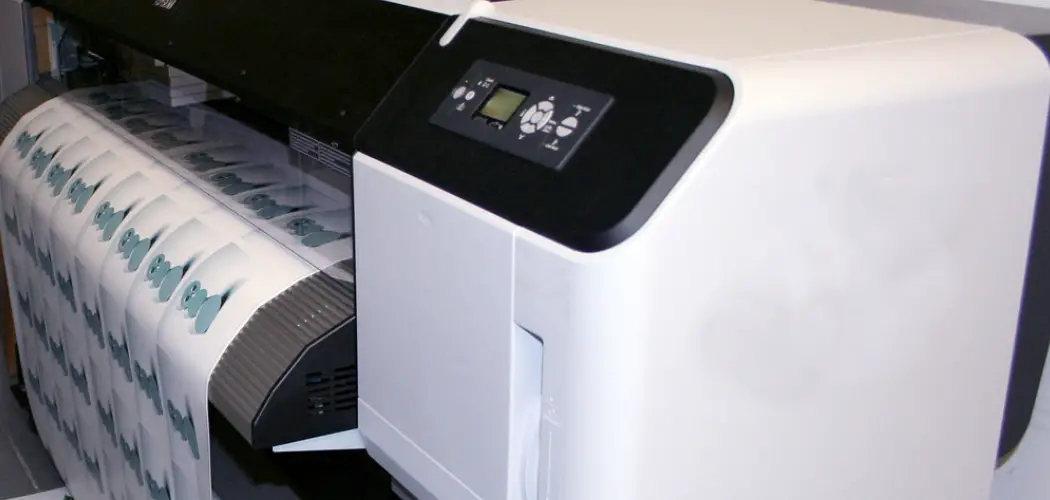When it comes to maintaining a tidy and organized workspace, finding ways to hide or conceal office equipment can be essential, especially for items that can disrupt the aesthetic of your environment.
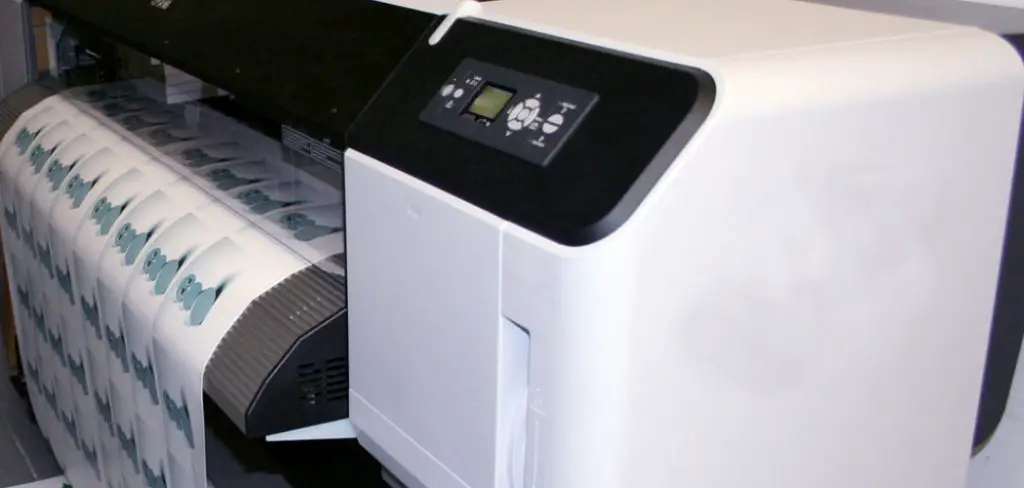
A printer, while necessary for day-to-day tasks, can often take up valuable space and create visual clutter. In this guide, we will explore how to hide a printer, making your workspace more visually appealing while ensuring that it remains functional and accessible when needed.
Whether you’re looking to hide it in plain sight or tuck it away completely, these ideas will help you achieve the perfect balance between utility and aesthetics.
The Challenge of Integrating Technology into Living Spaces
As technology continues to evolve and become an integral part of our daily lives, the challenge of seamlessly integrating it into our living spaces has become increasingly pronounced.
With devices like printers, monitors, and smart home gadgets often clashing with the aesthetic appeal of our homes, finding a way to harmonise these elements is essential. The key is striking a balance that allows for functionality without compromising the overall design.
Creative storage solutions, decorative coverings, and thoughtful placement can help transform these often bulky and utilitarian items into components that enhance rather than detract from the atmosphere of a space. By addressing this challenge, we can create environments that reflect our personal style while accommodating the demands of modern technology.
Benefits of Hiding a Printer
Concealing a printer in your workspace offers several benefits that extend beyond aesthetics. Firstly, it helps to create a clean and organized environment, reducing visual clutter and making your space feel more welcoming and professional. This can enhance focus and productivity, as an orderly workspace can lead to less distraction.
Additionally, hiding a printer can protect it from dust and potential damage, increasing its lifespan and reducing maintenance needs. It also provides a sense of cohesion in your decor, allowing for a more harmonious integration of technology within your existing design scheme. Overall, by effectively hiding a printer, you improve both the functionality and appearance of your workspace.
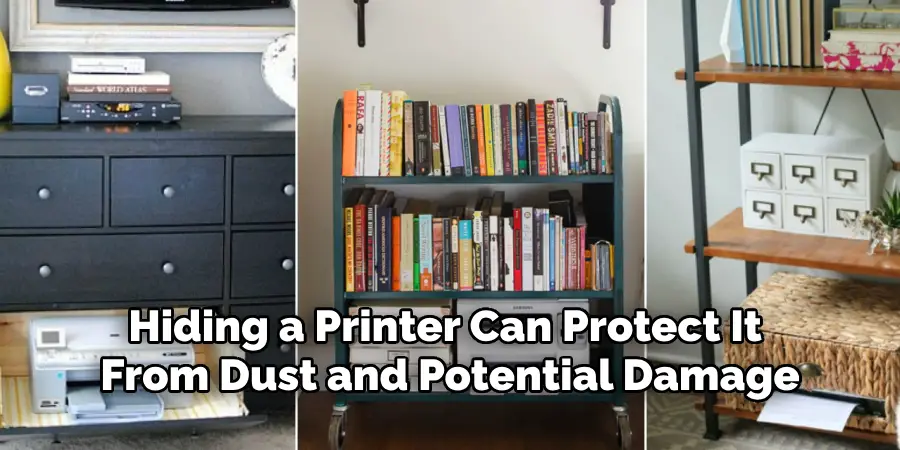
10 Methods How to Hide a Printer
1. Concealment Within a Cabinet or Desk Drawer
One of the most effective ways to hide a printer is to store it inside a cabinet or desk drawer. Many office furniture options come with built-in storage that is perfectly suited for housing a printer. To achieve this, choose a cabinet with doors that can be closed to completely conceal the printer when not in use.
Ensure that the cabinet or drawer is large enough to accommodate the printer’s dimensions, including space for paper to feed through and ventilation to prevent overheating. If you are using a drawer, ensure it can slide out easily to provide access to the printer when needed. Adding cable management solutions inside the cabinet will keep cords organized and out of sight.
2. Use a Printer Cover
A simple and cost-effective way to hide a printer is to use a custom printer cover. Printer covers come in various materials, such as fabric, leather, or vinyl, and can be selected to match the surrounding decor. A well-designed cover not only hides the printer but also protects it from dust and dirt.
If you’re feeling creative, you can make your own cover using fabric that complements your room’s aesthetic. This method is particularly useful in situations where the printer cannot be moved but still needs to blend in with the environment. The cover can be easily removed when the printer is in use and placed back on when it’s not.
3. Incorporate It into a Custom-Built Furniture Piece
For those with the resources and desire to integrate their printer seamlessly into their living or working space, custom-built furniture is an excellent option. A piece of furniture can be specifically designed to house the printer, with a compartment that allows it to be hidden from view.
For example, a side table with a sliding door or a shelf with a hidden compartment can serve as both a functional piece of furniture and a discreet printer storage solution. This method allows you to control every aspect of the printer’s placement, including accessibility, ventilation, and cable management.
4. Hide It Behind Decorative Screens or Panels
Decorative screens or panels provide a stylish way to conceal a printer while adding an element of design to a room. These screens can be placed in front of the printer to block it from view, yet can be easily moved or folded when access to the printer is needed.
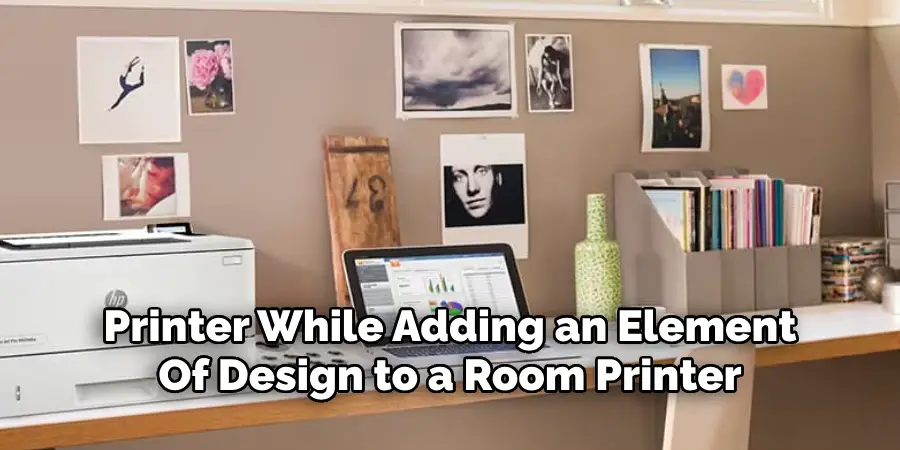
Decorative panels come in various materials, including wood, metal, or fabric, and can be selected to match the room’s theme. This method is particularly effective in open spaces where the printer is located on a desk or table but needs to be visually minimized. Additionally, screens or panels can be customized or DIYed to reflect personal style.
5. Use a Rolling Cart with a Curtain or Cover
A rolling cart with a curtain or cover offers both mobility and concealment for your printer. Choose a cart that fits the printer comfortably and allows for easy movement around the room. Attach a curtain or cover to the front of the cart, which can be drawn closed when the printer is not in use.
This method is highly versatile, as the cart can be moved out of sight when necessary and brought back when printing is required. The curtain can be made from any material that suits your decor, providing an opportunity to add a personal touch to the setup.
6. Place It Inside a Closet or Pantry
If space allows, placing the printer inside a closet or pantry is an excellent way to keep it out of sight. This method is particularly useful in home offices or smaller spaces where floor space is at a premium. By dedicating a shelf or compartment within a closet to the printer, you can keep it hidden behind closed doors.
Ensure that the closet has sufficient ventilation to prevent the printer from overheating during use. Adding a small, adjustable shelf inside the closet can also provide storage for paper, ink, and other printing supplies, keeping everything organized and easily accessible.
7. Hide It Behind a Sliding or Hinged Panel
A sliding or hinged panel can be used to hide a printer in a way that makes it easily accessible but invisible when not in use. Install a sliding or hinged door on a shelf, desk, or cabinet where the printer is stored.
When you need to use the printer, simply slide or open the panel to reveal it, and close it again when done. This method works well in modern and minimalist spaces where clean lines and simplicity are important. The panel can be made from the same material as the surrounding furniture or from a contrasting material to add a decorative element.
8. Disguise It as a Book or Decorative Box
For a more creative approach, consider disguising your printer as a book or decorative box. This method works particularly well for smaller printers or those that don’t need to be accessed frequently. You can use large, hollow books or boxes designed to look like books to encase the printer.
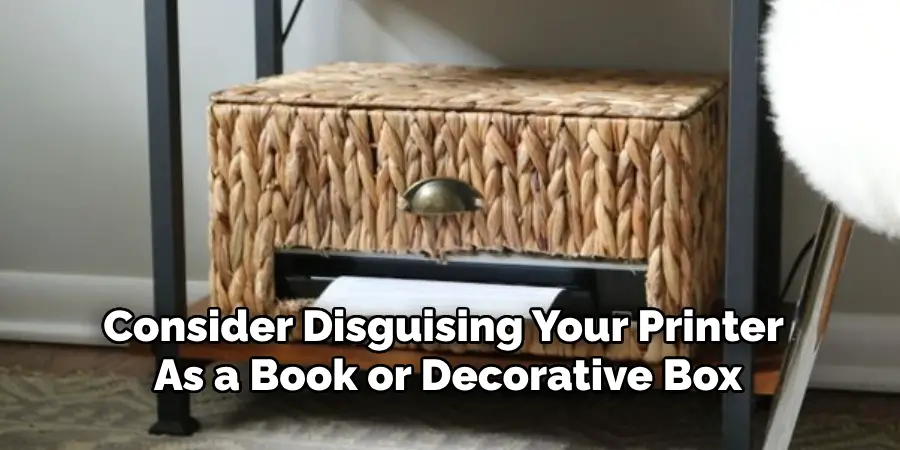
When placed on a bookshelf or desk, the printer will blend in seamlessly with other decor items. This method not only hides the printer but also adds an interesting and quirky element to the room’s design. Decorative boxes with lids that can be easily removed or opened provide similar concealment while allowing for quick access to the printer.
9. Use a Fold-Down Desk or Secretary
A fold-down desk or secretary desk is an ideal solution for hiding a printer in a compact and stylish way. These desks have a surface that folds up or down to conceal items stored inside, including a printer. When the desk is closed, the printer is completely hidden, and when opened, the desk provides a functional workspace with the printer easily accessible.
This method is particularly useful in small spaces or multi-purpose rooms where you want to maintain a clean, uncluttered look. The desk can also provide additional storage for office supplies, keeping everything organized and within reach.
10. Integrate It into a Multi-Functional Storage Unit
Multi-functional storage units, such as those with cubbies or compartments, can be used to hide a printer while offering additional storage for other items. Choose a storage unit with a compartment large enough to fit your printer, and use the surrounding cubbies for books, decorative items, or office supplies.
This method allows the printer to blend into the storage unit, making it less noticeable. To further conceal the printer, consider adding a door or curtain to the compartment where it is stored. This approach not only hides the printer but also maximizes the use of space in a room.
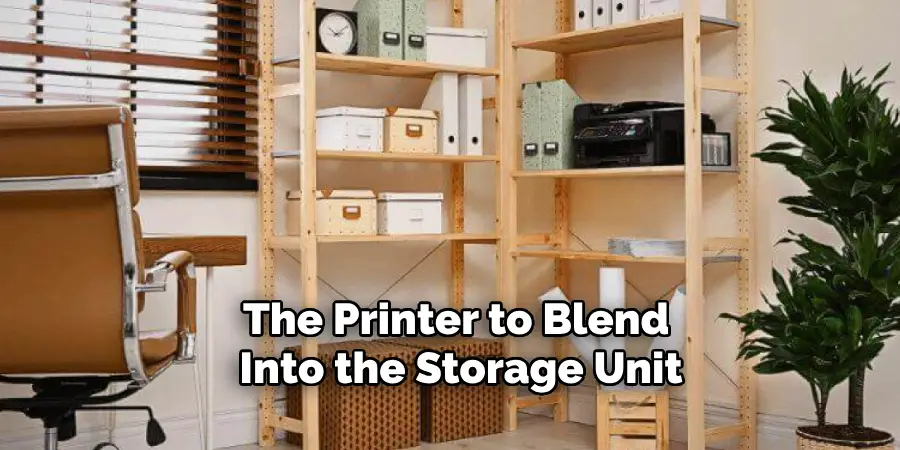
Conclusion
Hiding a printer doesn’t have to be a challenge. By using one of these ten methods, you can easily conceal your printer in a way that complements your decor while keeping it accessible for use.
Whether you choose to hide it in a cabinet, disguise it as a decorative item, or incorporate it into custom furniture, these strategies offer practical and stylish solutions for maintaining an organized and aesthetically pleasing space. Thanks for reading, and we hope this has given you some inspiration on how to hide a printer!

